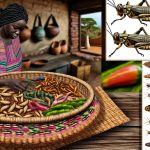Below, you will find examples of insects that are eaten at various places around the world. Even though many different species of insects can be eaten without risk to health, each food culture tend to have fairly strict ideas about what’s considered a “food-insect”.
Agave worm
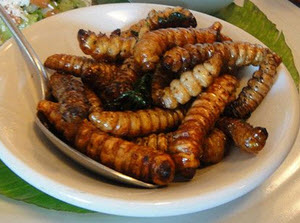 The agave worm has been made famous world-wide for its association with mezcal, a distilled alcoholic beverage made in Mexico from the plant Agave americana. The worm is usually the larva of the moth Hypopta agavis. This larvae does live on agave plants, but if you purchase a bottle of mezcal with a “worm” in it (mezcal con gusano), that worm has been added during the bottling process.
The agave worm has been made famous world-wide for its association with mezcal, a distilled alcoholic beverage made in Mexico from the plant Agave americana. The worm is usually the larva of the moth Hypopta agavis. This larvae does live on agave plants, but if you purchase a bottle of mezcal with a “worm” in it (mezcal con gusano), that worm has been added during the bottling process.
Various explanations have been proposed for why adding a worm to the mezcal became popular. Some suggest that is was merely a marketing ploy to get attention, while others have suggested that the worm was added to convince prospective buyers that the beverage had a high alcohol content (high enough to keep the worm preserved).
Mexico’s tequila regulatory council does not allow the inclusion of “worms” or scorpions in tequila bottles. Mezcal is not subjected to the same type of strict regulation, which is why we can still purchase mezcal bottles con gusano.
Bamboo borer
The bamboo borer, also known as the bamboo worm, is a considered a delicacy in Thailand, Laos, Burma and parts of China. It is the larvae of the moth Omphisa fuscidentalis and lives in bamboo groves and forests. Bamboo borers eat their way through bamboo.
The bamboo borer is usually eaten deep-fried. It is known as non mai phai and rot duan in Thai.
Bee
Several types of bee larvae are eaten around the world. Bee larvae are raised on royal jelly, pollen and honey and can become very rich in nutrients. Frying them in oil or butter is popular.
In China, adult bees are roasted and ground into a flour. This flour is considered a remedy for a sore throat.
Centipede
Various centipedes are sold as street food in China.
Chapulines (grasshoppers)
 In parts of Mexico, grasshoppers of the genus Sphenarium are collected for food. The name Chapulines comes from the Nahuatl language and their use as food predates the European arrival. Chapulines are collected from May and throughout the summer.
In parts of Mexico, grasshoppers of the genus Sphenarium are collected for food. The name Chapulines comes from the Nahuatl language and their use as food predates the European arrival. Chapulines are collected from May and throughout the summer.
A chapulin is prepared by being cleaned, washed and then roasted on a comal. Popular additions include lime juice, salt and chili. (Although chili is sometimes viewed with suspicion, as it could be an attempt to cover up stale chapulines.) Some recipes call for extract of agave worms.
Chapulines are strongly associated with Oaxaca where they are a popular snack, e.g. at sport events. They are also eaten as part of the filling in tacos or on a tlayuda.
In 2007, chapulines from the Oaxacan municipality Zimatlán de Alvarez turned out to contain dangerously high levels of led.
Crickets
 Crickets are found in most parts of the world below 55° North and above 55° South. The greatest diversity is found in tropical areas, and this is also were they are most commonly eaten. Examples of countries were crickets are considered more than just a novelty food are Thailand, Cambodia, Laos, Vietnam and Mexico. Crickets are roasted, fried or boiled. In Thailand, where deep fried crickets are a popular snack, roughly 20,000 farmers are involved in the cricket rearing business, with an estimated production of 7,500 tons annually.
Crickets are found in most parts of the world below 55° North and above 55° South. The greatest diversity is found in tropical areas, and this is also were they are most commonly eaten. Examples of countries were crickets are considered more than just a novelty food are Thailand, Cambodia, Laos, Vietnam and Mexico. Crickets are roasted, fried or boiled. In Thailand, where deep fried crickets are a popular snack, roughly 20,000 farmers are involved in the cricket rearing business, with an estimated production of 7,500 tons annually.
The house cricket (Acheta domesticus) has an average food conversion ratio of 1.7. This is approximately five times more than the ratio for rearing beef cattle. The cricket also has a reproductive rate that is much larger than that of beef cattle. Several projects have been launched to grow crickets and ground them into a protein rich powder that can be used in protein bars, cookies and pasta.
Many exotic pets, e.g. tropical frogs, are fed crickets. To make the diet more varied and nutritious for the pet, the crickets can be fed large amounts of the desired nutrients right before being given to the pet. This is known as “gut loading” the cricket.
Dragonfly
Adult and larval dragonflies are eaten in China and Indonesia, usually boiled or fried. In Indonesia, a reed is dipped in sticky palm sap and then waved in the air to catch adult dragonflies.
Dung beetle
In Isan, Thailand’s largest region, fried dung beetles are eaten, but dung beetles are getting increasingly scarce in farmed areas as water buffaloes are replaced by tractors.
In China, dried dung beetles are used in traditional Chinese medicine and known as qianglang.
Earthworms
Earthworms are included in the traditional diet of the Ye’kuana (So’to), a Native American people living in the tropical rain-forest along the Caura River and Orinoco River in Venezuela and in the north easternmost part of Brazil. Earthworms are high in protein and iron.
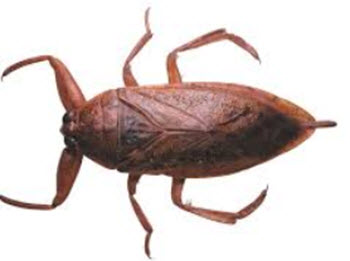 Giant Water Bugs
Giant Water Bugs
Many species of Giant Water Bugs (Family: Belostomatidae) can reach a size of 2 cm as adults, and the members of the genus Lethocerus can get nearly 5 cm long. Giant Water Bugs are popular food in South-East Asia, where they are steamed or fried, or use in sauces. If eaten raw, giant water bugs smells a bit like apple. When steamed, they develop a fishy consistency but smells like banana or melon. Lethocerus indicus is the most frequently harvested species.
Honeypot ant
Honeypot ants have specialized worker ants that can be filled with food and liquid. Their bellies will swell up enormously and they won’t be able to move around. They are fed by other workers and used as food storage. When needed, workers can extract food from these repletes by stroking them to make them regurgitate. Within the ant nest, the repletes are found deep underground.
Large honeypot ant repletes can swell up to the size of a grape and it not surprising that they are considered a delicacy well worth digging for. Honeypot ants are found in various parts of the world, especially in arid or semi-arid environments where it is important for ants to store food and liquid. The genera Camponotus and Melphorus are native to Australia, Leptomyrmex lives in Melanesia, Cataglyphis and Plagiolepis are African, and Prenolepis and Myrmecocystus are found in North America.
Honeypot ants, including the species Camponotus inflatus, are a part of the traditional diet of various Australian Aboriginal peoples. The nests are just dug up a bit and harvested, as to not destroy the food source for future needs.
In North America, the Paiutes of California reportedly ate honeypot ants (according to John Muir’s “First Summer in the Sierra”). Also, lumbermen living in Maine before the area was settled by Europeans would supplement their diet with honeypot ants.
Honeypot ants are also found in parts of Africa. The San people are known to include several species in their traditional diet.
Hormiga culona (Big-Butted ant)
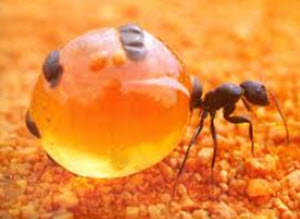 Atta laevigata is a leaf-cutter ant found in South America, from Venezuela to Paraguay. It one of the largest species of leaf-cutter ant and its Spanish name, Hormiga culona, roughly translates into Big-Butted Ant.
Atta laevigata is a leaf-cutter ant found in South America, from Venezuela to Paraguay. It one of the largest species of leaf-cutter ant and its Spanish name, Hormiga culona, roughly translates into Big-Butted Ant.
Hormiga culona has been eaten in the regions since long before European colonization. The ants are harvested for roughly nine weeks per year, when they make the nuptial flight, and they can be an important source of income for people in the countryside, especially in San Gil and Barichara in Colombia. A majority of the harvest is eaten within South America, but some is exported to North America, Europe and South-East Asia.
Hormiga culona is a traditional wedding gift and nowadays they are also sold as snacks in movie theaters in Colombia. The hormiga culona isn’t eaten raw – it is soaked in salty water and then roasted.
Like many other ants, hormiga culona is high in protein and low in saturated fat.
Housefly pupae
The pupae of the common housefly Musca domestica has a fatty acid pattern resembling that of certain fish oils. The pupae are red and taste like iron rich food.
Jumiles
Jumiles are small stink bugs native to the Taxco region of Mexico. A majority of the jumiles consumed there belong to the species Atizies taxcoensis, but pretty much any tasty bug from the family Coreidae or Pentatomidae will be considered jumiles.
Jumiles taste bitter with a hint of cinnamon. The bitterness is largely due to iodine. Some have analgesic properties. Jumiles are served roasted, fried or raw. They can be eaten whole or grounded. Sometimes whole jumiles are eaten alive. A popular salsa is made from mashed jumiles, fresh tomatoes, chili and onions.
The jumile season starts on November 1 and continues until the first rains (usually in February). The jumile premier is celebrated with a large Jumile Fiesta in Huisteco, Taxco. During the annual Jumile Fiesta, thousands of jumiles will be cooked and devoured, and a Jumile Queen is crowned.
Lemon ant
The Lemon ant (Myrmelachista schumanni) tastes a bit similar to lemon, hence the name. The lemony taste comes from acids that are a part of the ant’s defense system. When the ant is attacked or crushed, cintronellal pheromones are emitted to warn other members of the colony.
Lemon ants live in the Amazonas where they produce a formic acid herbicide and use it to kill all the plants in an area except for the Duroia hirsuta tree. If you encounter an area where almost no other plants are living, only Duroia hirsuta trees, you have found a lemon ant habitat. The lemon ants live in Duroia hirsuta trees and kill off other plants to promote the growth of Duroia hirsuta. The lemon ants will also defend the trees from herbivores. Large colonies with 15,000 ant queens and over 3 million workers have been found, and a colony can live for hundreds of years.
Locust
Eating locust is condoned by the Bible. The are specifically mentioned as non-forbidden in Leviticus in the Old Testament, and in the New Testament, both Matthew 3:4 and Mark 1:6 talks about how John the Baptist survives in the desert by eating locusts and wild honey.
| All fowls that creep, going upon all four, shall be an abomination unto you.
Yet these may ye eat of every flying creeping thing that goeth upon all four, which have legs above their feet, to leap withal upon the earth; Even these of them ye may eat; the locust after his kind, and the bald locust after his kind, and the beetle after his kind, and the grasshopper after his kind. But all other flying creeping things, which have four feet, shall be an abomination unto you. – Bible (King James), Leviticus 11:20-23 |
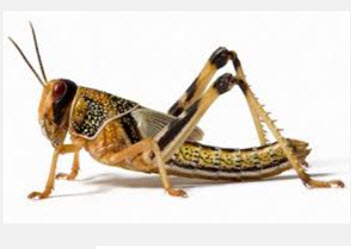 Locusts are eaten in many cultures in Asia and Africa, including the Middle East. To preserve large amounts of locust for future needs, smoking or drying have been popular methods. The Torah lists certain locust families as kosher, and in Islamic jurisprudence, eating locust is halal. The Persian anti-arab slur “malakh-khor” means locust eater.
Locusts are eaten in many cultures in Asia and Africa, including the Middle East. To preserve large amounts of locust for future needs, smoking or drying have been popular methods. The Torah lists certain locust families as kosher, and in Islamic jurisprudence, eating locust is halal. The Persian anti-arab slur “malakh-khor” means locust eater.
Locusts have a high conversion ratio. Compared to cattle, locusts yield an average of five times as much protein per unit of fodder and they produce much less greenhouse gases in the process.
Pesticides used to combat locusts can make them unsuitable for human consumption.
Madagascar Hissing Cockroach
There are roughly 20 species of Hissing Cockroach on Madagascar, of which the most well-known one is Gromphadorhina portentosa. Gromphadorhina portentosa is one of the largest of all cockroach species in the world and can be up over 7 cm long as an adult. It’s texture has been described as similar to greasy chicken. It is served toasted, fried or boiled.
In September – October 2006, the U.S. amusement park Six Flags Great America granted unlimited line-jumping privileges to anyone who could eat a live Madagascar Hissing Cockroach. They also promised four season passes to the first participant to beat the old world record (36 cockroaches in 1 minute). Beating this record is a bit complicated, because raw cockroaches can contain a mild neurotoxin that will numb the mouth and throat and make it difficult to swallow.
Magicicada (cicadas)
Magicicada is a genus of periodical cicadas living in eastern North America. The nymphs in an area will emerge simultaneously in large numbers, sometimes more than 1.5 million individuals per acre. Historically, Native Americans in the area would gather them and roast them in hot ovens before eating them.
In 1907, Charles Lester Marlatt wrote about “the instinctive repugnance which all insects seem to inspire as an article of food to most civilized nations” while also pointing out that “theoretically, the Cicada, collected at the proper time and suitably dressed and served, should be a rather attractive food. The larvae have lived solely on vegetable matter of the cleanest and most whole-some sort (…)”.
Asian Cicada species are eaten in South-East Asia.
Mealworms
Mealworms are the larval form of the mealworm beetle, Tenebrio molitor, a species of darkling beetle. Larvae typically measure about 2.5 cm or more. Baked mealworms are marketed as a healthy snack. They can be easily reared at home.
Mopane worm
The mopane worm is the caterpillar of the emperor month Gonimbrasia belina. It lives in warm parts of southern Africa and the mopane tree is its primary food plant.
Nsenene (grasshopper)
This grasshopper is popular in Uganda, where it is served fried.
Sago grubs
The red palm weevil (Rhynchophorus ferrugineus) is a species of snout beetle, also known as the Asian palm weevil or Sago weevil. The larva is a delicacy in parts of South-East Asia, including Malaysia, Indonesia, Borneo and Papau New Guinea.
 Scorpion
Scorpion
Large scorpions are skewered and fried in Thailand and China. They taste similar to soft-shell crabs.
Silkworm pupae
Silkworm pupae is the pupae of the domesticated silkmoth, Bombyx mori. It is a by-product of the silk-harvesting business. The pupae can be boiled to extract the silk, and then the rest is eaten directly or fried with chili pepper. Street vendors in China sell roasted pupae, while those available in the streets of Korea tend to be boiled (beondegi). In Japan, they are boiled and served with sweet-sour sauce.
Sompopos de Mayo
In May, flying ants known as Sompopos emerge in parts of Guatemala, where they are gathered and eaten. The egg-filled part of the ant is removed and the rest of the ant is discarded. The egg-part is roasted on a comal and servied with salt and lime juice.
It is the queen Sampopos that fly, since they wish to find new places suitable for ant colonies. The spend the rest of the year underground. Since they only appear in May, they are known as Sompopos de Mayo (May Sompopos). They are 4-5 times larger than ordinary wingless Sompopos.
Tarantula
In Cambodia, tarantulas are believed to increase virility. The taste is similar to crabs, but more earthy and less salty.
Termites
In Kenya, termites are eaten raw straight out of the termite mount.
Walking sticks
Walking sticks (Order: Phasmatodea) are eaten in Papua New Guinea.
Wasp
Wasps are eaten both as larvae and adults. The Japanese Emperor Hurohito (Shōwa) liked to eat boiled wasps served with rice. Wasps can also be fried or roasted. They have a buttery taste.
Waxworm
This is the larvae of the wax moth. The waxworm lives as a parasite in bee hives. You can raise them without a bee hive if you feed them honey and bran. When roasted, they taste similar to pine nut.
Witchetty grub
Witchetty grub is the large and tasty wood-eating larvae of various cossid moths (Endoxyla), ghost moths (Hepialidae) and longhorn beetles (Cerambycidae). The species most strongly associated with the dish is Endoxyla leucomochla, which feeds on the roots of the Witchetty bush in central Australia.
In Australian Aboriginal cuisine, the larvae is roasted over coals or over fire, or lightly cooked in hot ashes. The taste has been described as nutty scrambled eggs in a crisp skin. The larvae are high in both fat and protein, and has historically been very important for people in arid parts of Australia.
Raw witchetty grub has an almondy taste.
Woodlouse
There are over 5,000 known species of woodlouse. They are crustaceans belonging to the suborder Oniscidea within the order Isopoda. Some species can roll up into a nearly perfect sphere, which has given them common names such as armadillo bug, roly-poly and pill bug.
As crustaceans, woodlice are fairly closely related to crabs, lobsters and shrimps and can be eaten in a similar way.

